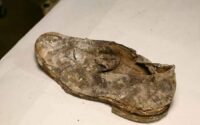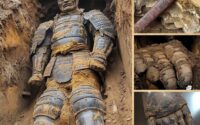The Siberian Grave Enigma: A Warrior Couple, an Elder, and a Newborn Spark Online Frenzy .bongbenh
On October 9, 2020, a post from @archaeologymag on X sent shockwaves through the online community: “The 2,500-year-old remains of a man, a woman, a newborn infant, and an older woman have been discovered in a Scythian burial in southern Siberia alongside bronze daggers, knives, axes, mirrors, and a miniature comb made of animal horn.” The announcement, detailing a grave from the ancient Tagar culture in Siberia’s Khakassia region, seemed straightforward—yet its implications have ignited a firestorm of curiosity and confusion. Why were a warrior couple, an elderly woman, and a newborn buried together? What do the weapons and artifacts reveal about their lives? And could this untouched tomb hold secrets that challenge our understanding of the past? As Reddit threads, X posts, and blogs dissect the find, the grave has become a digital puzzle, blending awe with speculation about ancient rituals, lost civilizations, and even otherworldly connections.
A Tomb Frozen in Time
The grave, unearthed in southern Khakassia at the foot of Mount Aar-tag, dates to around 500 BCE, placing it in the early Iron Age within the Tagar culture, a subset of the nomadic Scythian civilization that thrived in Siberia’s Minusinsk Basin from the 8th to 3rd centuries BCE. The discovery, led by the Siberian Branch of the Russian Academy of Sciences, revealed four skeletons: a man and woman in their 30s or 40s, presumed to be warriors; an older woman, about 60, buried at their feet in a curled position; and a newborn, no more than a month old, whose remains were scattered, likely by rodents. Alongside them lay an arsenal of bronze weapons—daggers, knives, axes—a bronze mirror, and a horn comb, all remarkably intact despite 2,500 years underground.
The find’s preservation is extraordinary, as most Tagar graves are looted, their contents scattered or stolen. Yuri Vitalievich Teterin, head of the excavation, noted the rarity of such an untouched burial, discovered ahead of a railroad project. The man and woman, laid on their backs with large ceramic vessels of mutton and beef beside them, were armed for battle: he with two daggers and two axes, she with a long-handled hatchet or axe and a short sword—unusual for Tagar women, who were typically buried with long-range weapons like bows. The older woman, positioned differently, had only a broken comb and a small ceramic vessel, hinting at lower status. The newborn’s fragmented remains added a tragic note, raising questions about their collective fate.
A Warrior Couple and Their Mysteries
The designation of the man and woman as a “warrior couple” has captivated the internet, particularly the woman’s weaponry. Unlike other Tagar female warriors, who carried bows, this woman was equipped for close combat, suggesting a unique role in a society where violence was “an acceptable and legal way to solve problems,” according to archaeologist Anatoly Vybornov. Online, this has sparked debates about gender roles in Scythian culture. Was she an elite fighter, a leader, or part of a broader tradition of warrior women, like the Amazons described by Herodotus? A 2020 DNA study of a Scythian burial confirmed a young female warrior, lending credence to such legends.
Yet, the “couple” label raises questions. Were they spouses, siblings, or comrades-in-arms? A forthcoming DNA analysis may clarify their relationship, but for now, speculation runs wild. Reddit’s r/ArtefactPorn questioned the romantic framing, with user u/Molech996 arguing that the “warrior couple” narrative might reflect modern biases, as farmers could carry similar weapons for protection. The man’s dual axes and daggers suggest high status, but the woman’s hatchet—a rare find—hints at a distinct role, perhaps ceremonial or elite. X users have proposed she was a “warrior princess,” though others dismiss this as a trope, citing the rarity of metal weapons among non-warriors.
The cause of death adds intrigue. With no visible battle wounds, archaeologists hypothesize that all four died from a shared infection. But online, some question this: Could it have been poison, a ritual sacrifice, or something stranger? A Reddit thread suggested an “overbearing step-mother-in-law” poisoning the family, a playful yet grim theory with no evidence but plenty of traction. The infection theory aligns with the newborn’s presence, as infants were vulnerable to disease, but the lack of clarity keeps the mystery alive.
The Elder and the Newborn: Servants or Kin?
The older woman, buried in a fetal position at the couple’s feet with meager possessions, is a focal point of confusion. Described as a possible “servant” to tend the family in the afterlife, her placement suggests lower status. Yet, Reddit users challenge this, asking why she couldn’t be a grandmother or aunt, noting that “servant” implies a power dynamic not necessarily supported by evidence. Her broken comb and small vessel contrast with the couple’s weapons and food-filled ceramics, believed to aid in the afterlife. Could she have been a caretaker for the child, buried to continue her role, or was her position a sign of ritual humiliation?
The newborn’s scattered remains are equally perplexing. Rodent activity likely disturbed the bones, but why was the infant buried with the others? Was it the couple’s child, a sibling, or a symbolic inclusion? Some X users speculate the burial reflects a family tragedy, with the infant’s death tying to the infection hypothesis. Others propose a ritualistic element, drawing parallels to Scythian practices where children were buried with elites to signify lineage or sacrifice. The lack of clarity has led to wild theories, including one X post suggesting the newborn’s remains were deliberately scattered as part of a “cosmic ritual” to connect the living and dead.
Artifacts and Alien Whispers
The grave goods—bronze daggers, axes, mirrors, and a horn comb—are typical of Tagar burials, symbolizing needs in the afterlife. Unlike many Tagar graves with miniature replicas, these were full-sized, hinting at the occupants’ importance. The bronze mirror, often linked to female burials, may have had ritual significance, while the weapons suggest readiness for battle beyond death. But online, these artifacts have sparked outlandish theories. A 2025 X post linked the find to earlier claims of “not of this Earth” discoveries in burial mounds, suggesting the weapons could be made of an unknown alloy. Though no evidence supports this, the idea resonates with those citing Scythian myths of divine or extraterrestrial origins.
The comb, described as “miniature” and made of horn, has drawn particular attention. Was it a practical tool or a ceremonial object? Some Reddit users propose it was a status symbol for the older woman, undermining the “servant” label. Others, on X, compare it to artifacts from the nearby Arzhan 2 tomb, where a royal couple was buried with 9,000 gold objects, suggesting a connection to elite Scythian rituals. The possibility of a “Siberian Valley of the Kings,” as the region is dubbed, fuels speculation about undiscovered tombs holding even stranger finds.
Online Frenzy and Cultural Questions
The post’s viral spread—3,798 votes on r/ArtefactPorn and thousands of X retweets—has turned the grave into a digital mystery. Users debate the burial’s social dynamics: Why was the older woman positioned so differently? Could the couple’s weapons indicate a dual-leadership role? The infection hypothesis is questioned, with some suggesting a mass sacrifice or even a cover-up of a more violent end. A 2025 X thread speculated the grave was a “time capsule” from a lost Scythian sect, with the newborn as a “key” to an ancient prophecy—pure conjecture, but reflective of the internet’s love for the fantastical.
Cultural assumptions also spark debate. The “servant” label for the older woman has been criticized as Eurocentric, ignoring Scythian traditions where elders held revered roles. The warrior couple’s equal armament challenges modern gender norms, echoing 2020 findings of female Scythian warriors with combat gear. Some X users tie the grave to Herodotus’s tales of Amazons, while others argue it reflects a society where women fought as equals. The lack of DNA results keeps these questions open, with users eagerly awaiting clarity on familial ties.
Ethical concerns surface too. Should such graves be excavated or left undisturbed? The display of human remains, like the nearby Arzhan 2 finds, raises questions about respect for the dead. Reddit users debate whether the “servant” narrative dehumanizes the older woman, while X posts call for repatriation of artifacts to local communities, though Khakassia’s sparse population complicates this.

A Puzzle Without End
The Siberian grave remains an enigma, its four occupants and their weapons a window into a lost world. Was this a family struck by tragedy, a ritual burial, or something stranger? The online community’s obsession lies in its unanswered questions: What bound these people together? Why the unusual weaponry? And what secrets might the DNA reveal? As one Reddit user put it, “This grave feels like it’s telling a story we’re not ready to hear.”
Join the conversation on X or Reddit, share your theories, and let the mystery of this 2,500-year-old tomb keep you guessing. Whether a tale of warriors, kin, or cosmic rites, the Siberian grave’s secrets endure, challenging history and sparking the imagination.


